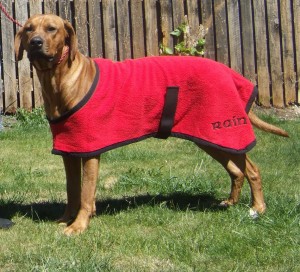In a nutshell, heatstroke occurs when a dog is subjected atmospherically to high temperatures so that might be where a dog cannot get out of the heat, for example if they are left in a car in warm weather – or perhaps if you have a “sun-worshiper” who just loves to be out baking his brain in the sunshine all day and doesn’t know when enough sun is enough. In your capacity as responsible dog-owner, its up to you to try to make sure your dog doesn’t stay too long in the sun.
A great tip (courtesy of Lothlorien Dog Services: http://www.lothloriendogservices.co.uk/) is to provide a towel, soaked in cold water, spread out on the garden for them to lie on. The cold towelling on their underside is very refreshing.
So, how long is too long? Well, that depends very much on the individual dog and the strength of the sun, but things that can exacerbate this condition include:
- heavy panting
- hyperventilation (deep breathing)
- increased salivation early then dry gums as the heat prostration progresses
- weakness
- confusion or inattention
- vomiting or diarrhoea
- lack of appetite
- glazed/confused expression
As the condition progresses towards heat stroke there may be:
- shallowing of the breathing efforts
- slowed or absent breath efforts
- obvious paleness or graying to the gums
- vomiting and diarrhoea that may be bloody
- seizures or coma
http://dogs.about.com/od/dogandpuppyhealth/qt/heatstroke.htm http://www.petmd.com/dog/conditions/cardiovascular/c_dg_heat_stroke http://pets.webmd.com/dogs/heat-stroke-dehydration-dogs http://www.canine-epilepsy-guardian-angels.com/heat_illnesses.html http://www.dogstrust.org.uk/az/h/heat/heatstrokelandingpage09.aspx http://www.peteducation.com/article.cfm?c=2+1677&aid=1683 http://www.wikihow.com/Treat-Heat-Stroke-in-Dogs



